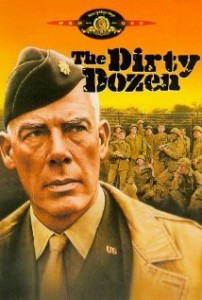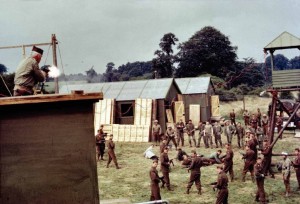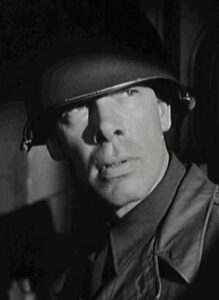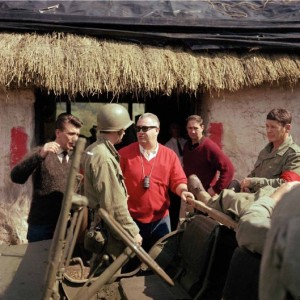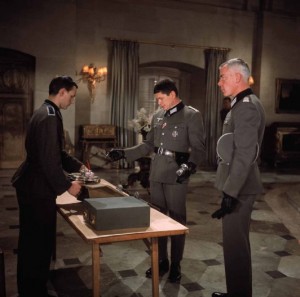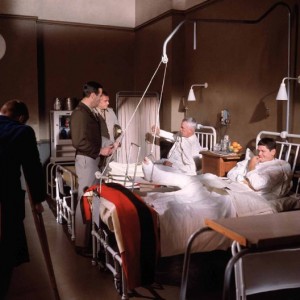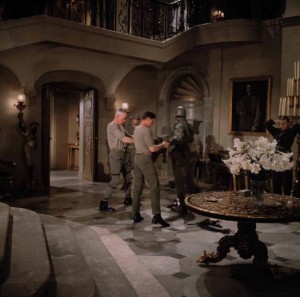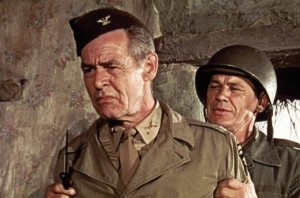The Dirty Dozen ***** (1967, Lee Marvin, Ernest Borgnine, Charles Bronson, Robert Ryan, Jim Brown, George Kennedy, John Cassavetes, Donald Sutherland) – Classic Movie Review 813
Robert Aldrich’s 1967 World War Two action movie The Dirty Dozen is a fondly remembered, often screened blockbuster smash-hit. It’s not a subtle film but it is a brilliantly exciting one, with an iconic cast.
Director Robert Aldrich’s 1967 World War Two wartime action movie The Dirty Dozen is a fondly remembered, often screened blockbuster smash-hit. It’s not a subtle film but it is an thoroughly exciting one, with an iconic cast of the era.
It centres on renegade US Army Major Reisman (Lee Marvin), who is ordered to interview military prisoners with death sentences or long terms and sign up 12 of them for an ultra-dangerous mission that they are not expected to survive. He then has to train them and lead them by parachute behind enemy lines on an attempted mass assassination of German officers at a chateau rest house on the eve of D-Day. The Dirty Dozen suicide squad attack the chateau, gleefully slaughtering the German officers and civilians alike.
Entertaining and gripping, crude and violent, it is thumpingly performed, especially by Marvin, Ernest Borgnine (General Worden), Robert Ryan (Colonel Everett Dasher Breed), Jim Brown, George Kennedy (Major Max Armbruster), John Cassavetes, Charles Bronson and a then unknown Donald Sutherland, as Vernon Pinkley.
Richard Jaeckel (as Sergeant Bowren), Trini Lopez, Telly Savalas (Archer Maggott), Ralph Meeker (Captain Stuart Kinder), Clint Walker (as 6 ft 6 in meek convict Samson Posey) and Robert Webber are also all essential members of a great cast of tough guys.
Very much in his element, Aldrich provides the kind of skilled, adroit, robust direction that turns a good idea and fine script into a memorable movie. In one way it’s a straightforward action movie, with no obvious agenda other than to entertain. But, as well as being exciting and realistic, the surprise is that it’s such a complex film too, and at its heart even quite thoughtful.
Avoiding any blatant patriot flag-waving, it gives off ambiguous messages. Entertainingly, it was perceived in different quarters as both an anti-war film and pro-war movie. I guess we all have to make up our own minds about it.
Aldrich was a complicated man and an unusual director. A man’s man movie-maker, famed for Vera Cruz (1954), Kiss Me Deadly (1955), The Big Knife (1955), The Flight of the Phoenix (1965) and The Longest Yard (1974), he was also the maker of Autumn Leaves (1956), What Ever Happened to Baby Jane?, Hush, Hush Sweet Charlotte and The Killing of Sister George.
The Dirty Dozen was filmed in England at MGM British Studios in Borehamwood and on location at Hendon Aerodrome and in Buckinghamshire and Hertforshire. Ashridge Management College, Little Gaddesden, Hertfordshire, stands in for Tyne Military Prison where The Dirty Dozen are recruited.
Nunnally Johnson and Lukas Heller’s believable script is based on E M Nathanson’s possibly fact-based novel, with a basic idea that bears a passing resemblance to The Magnificent Seven.
The Dirty Dozen: The Next Mission, directed by Andrew V McLaglen, followed in 1985, spawning a series of popular TV movies.
Cassavetes (as Victor Franko) was Oscar and Golden Globe nominated as Best Supporting Actor. John Poyner won the film’s only Oscar for Best Sound Effects.
Unusually for the day, the opening credits don’t occur until 10 minutes into the film. Kennedy, Walker, Borgnine and Brown were reunited to voice the soldiers 31 years later in Small Soldiers.
Clint Walker (born May 30, 1927)
Ernest Borgnine on The Dirty Dozen: ‘Some of the most fun I had on movie sets was working with my buddy Lee Marvin. When it was Lee, Charles Bronson and Bob Aldrich, it was pure heaven.’
Ernest Borgnine (January 24, 1917 – July 8, 2012) was born Ermes Effron Borgnino, in Hamden, Connecticut, the son of Italian immigrants.
Lee Marvin also stars in Robert Aldrich’s 1956 film Attack! and his 1973 film Emperor of the North Pole.
http://derekwinnert.com/what-ever-happened-to-baby-jane-film-review/
© Derek Winnert 2014 Classic Movie Review 813
Check out more reviews on http://derekwinnert.com/

